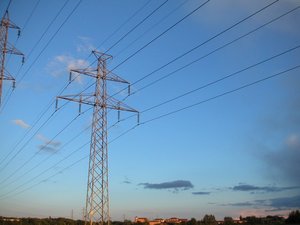Electric power
|
|
Electric power, often known as power or electricity, involves the production and delivery of electrical energy in sufficient quantities to operate domestic appliances, office equipment, industrial machinery and provide sufficient energy for both domestic and commercial lighting, heating, cooking and industrial processes.
| Contents |
History
Although electricity had been known to be produced as a result of the chemical reactions that take place in an electrolytic cell since Alessandro Volta developed the voltaic pile in 1800, its production by this means was, and still is, expensive. In 1831, Michael Faraday devised a machine that generated electricity from rotary motion, but it took almost 50 years for the technology to reach a commercially viable stage. In 1878, Thomas Edison developed and sold a commercially viable replacement for gas lighting and heating using locally generated and distributed direct current electricity. The reason generation close to or on the consumer's premises was necessary was that Edison had no means of voltage conversion. The voltage chosen for any electrical system is a compromise. Increasing the voltage reduces the current and therefore reduces resistive losses in the cable. Unfortunately it increases the danger from direct contact and also increases the required insulation thickness. Furthermore some load types were difficult or impossible to make for higher voltages.
Nikola Tesla, who had worked for Edison for a short time and appreciated the electrical theory in a way that Edison did not, devised an alternative system using alternating current. Tesla realised that while doubling the voltage would halve the current and reduce losses by three-quarters, only an alternating current system allowed the transformation between voltage levels in different parts of the system. This allowed efficient high voltages for distribution where their risks could easily be mitigated by good design while still allowing fairly safe voltages to be supplied to the loads. He went on to develop the overall theory of his system, devising theoretical and practical alternatives for all of the direct current appliances then in use, and patented his novel ideas in 1887, in thirty separate patents.
In 1888, Tesla's work came to the attention of George Westinghouse, who owned a patent for a type of transformer that could deal with high power and was easy to make. Westinghouse had been operating an alternating current lighting plant in Great Barrington, Massachusetts since 1886. While Westinghouse's system could use Edison's lights and had heaters, it did not have a motor. With Tesla and his patents, Westinghouse built a power system for a gold mine in Telluride, Colorado in 1891, with a water driven 100 horsepower (75 kW) generator powering a 100 horsepower (75 kW) motor over a 2.5-mile (4 km) power line. Almarian Decker finally invented the whole system of three-phase power generating in Redlands, California in 1893. Then, in a deal with General Electric, which Edison had been forced to sell, Westinghouse's company went on to construct a power station at the Niagara Falls, with three 5,000 horsepower (3.7 MW) Tesla generators supplying electricity to an aluminium smelter at Niagara and the town of Buffalo 22 miles (35 km) away. The Niagara power station commenced operation on April 20 1895. Its opening set the scene for the electric power industry for over a hundred years.
Electric power today
Today, Tesla's alternating-current electric power system is still the primary means of delivering electrical energy to consumers throughout the world. While high-voltage direct current (HVDC) is used to transmit large quantities of electricity over long distances, the bulk of electricity generation, transmission, distribution and supply takes place using alternating current.
In many countries, electric power companies own the whole infrastructure from generating stations to transmission and distribution infrastructure. For this reason, electric power is viewed as a natural monopoly. The industry is generally heavily regulated, often with price controls and is frequently government-owned and operated. Since the reform of the electricity supply industry in England and Wales in 1990, there has been a movement towards separating the monopoly parts of the industry (ie the transmission and distribution sectors) from the contestable sectors (ie generation and retailing) across the world. In some countries, wholesale electricity markets operate, with generators and retailers trading electricity in a similar manner to shares and currency.
See also
- AC power
- Electricity generation
- Electric power transmission
- Electricity distribution
- Power (physics)
- Distributed generation
- Electricity retailing
- Auxiliary power
- Power control
- Power factor
- Electrical wiring
- Uninterruptible power supply
- Electrical generator
- Electrical bus
- New Zealand Electricity Market
- Electricity market
- Transformer
- Three-phase power
- Electronics
- Mains power plug
- Mains electricity ("household electricity" in American English)
- Industrial power plug
- Power budget
- Power connector
- Power failure transfer
- Power margin
- Power plant
- Power supply
- Power system automation
- Skin effect
Further reading
- The Man Who Invented the Twentieth Century - Nicola Tesla, Forgotten Genius of Electricity, Robert Lomas, Headline Book Publishing, London, 1999.
- Industrial Electronics for Engineers, Chemists, and Technicians, by D. J. Shanefield, William Andrew Publishing, Norwich, NY, 2001.da:Effekt (fysik)#Effekt i elektriske kredslřb
de:Elektrische Leistung es:Sistema de suministro eléctrico et:Vőimsus#Vőimsus elektrotehnikas fr:Puissance#En électricité ja:電力 nl:Vermogen (natuurkunde) pt:Potęncia elétrica sl:Moč#Električna moč sv:Effekt#För likström (DC) och spänning

